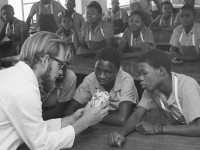Synopsis of a
Documentary Film
THE MENNONITES: A PEOPLE APART (working title)
Audience: General broadcast North American audience
Social Media audience through a variety of social media platforms
Format: High Definition Video
Rationale: The term “Mennonite” is quickly becoming shorthand for expressing certain concepts in popular culture. While once mostly ignored, Mennonites are finding themselves noted in films, music, publications, television and in social media such as YouTube and Vimeo.
To what can this uptick in national curiosity be attributed? Has the attention turned to Mennonites because of what the public perceives as an alternative to the coarsening of public life and discourse? Is it the media representation of Mennonites as naïve throwbacks to an earlier time that triggers a nostalgic reaction to modern living? Or is it something else altogether?
Mennonites represent what is arguably the broadest religious experience in America. This experience encompasses both those few adhering to horse drawn transportation and those driving Lexus autos to their suburban workplaces. In the United States today those identifying as Mennonites number approximately 400,000. Roughly half carry the label of ‘conservative,’ meaning that they have more tenaciously retained their German language and historic cultural mores. Of these, a few continue to use horse drawn equipment in their farming operations.
Their influence on American society belies their small numbers.
- At the height of the Protestant Reformation, Mennonites in Europe insisted that the state not interfere in the affairs of the church. By re-baptizing themselves they denounced the state’s claim on their lives. Thousands were tortured and burned at the stake for such a radical idea. Some scholars mark this as the beginning of the modern age. Separation of church and state was necessary for democracies to emerge. Indeed, 250 years later the Constitution of the United States codified such separation.
- There are no known records of Mennonites owning slaves. Always suspicious of war, they were caught up as ambivalent outliers during the Civil War. Forcibly compelling young Mennonite men into his militia, Stonewall Jackson found them to be ineffective fighters. They refused to take aim at another human. Exasperated, Jackson finally left them to their farming enterprises, something they did better than fight, he noted.
- Their conscientious objection to military service paid unintended dividends to America when young men assigned to mental hospitals in lieu of military service discovered the inhuman care given patients there. They reacted by creating a chain of Mennonite-operated mental care facilities where patients received compassionate care, an act that precipitated reform of the nation’s mental health system.
- Along with other faith groups with pacifistic leanings, Mennonites participated in a movement that codified conscientious objector status for all young conscripts, regardless of religious affiliation.
- Coming to the US from Russia, Mennonites brought with them Turkey Hard Red winter wheat and advanced farming practices that turned the arid Great Plains into the nation’s bread basket.
- In 1851 Joseph Funk, music teacher, composer and author, invented a shaped note system for his “Harmonia Sacra,” a gospel song book that influenced gospel music to the extent that his home in Singers Glen, Virginia is sometimes noted as the birthplace of gospel music in the American South. His “Harmonia Sacra” is still published and in use today.
- In a videotaped interview, folk singer and song writer John Denver speaks of the importance that working on Kansas and Oklahoma wheat harvests with his Mennonite uncle had on his appreciation for the land and nature. He wrote “Matthew’s Song” as a direct result of his uncle’s untimely death.
- Believing that actions validate faith, Mennonites arrive early at the scenes of natural disasters. Mucking out flooded homes, cleaning up after tornadoes, and rebuilding homes for the dispossessed, free of charge, has caught the attention of the nation. Institutionalized as Mennonite Disaster Service, the organization works closely with the Federal Emergency Management Agency (FEMA), the Red Cross and other disaster recovery agencies.
- Mennonites view service as one of their core values. Through Mennonite Central Committee-sponsored programs teachers, agricultural extension workers, micro enterprise experts, nurses, community development workers, doctors, relief workers and peace advocates give several years of their lives to projects in countries emerging from poverty.
- Mennonites engaged in business created Mennonite Economic Development Associates, an agency offering innovative solutions to help budding entrepreneurs rise from poverty through a variety of world-wide initiatives. This group pioneered the concept of micro loans given through local cooperatives, preceded by microenterprise business training, whereby cooperative members maintain control of the giving and repayment of small loans. Successful loan repayment equals or exceeds that experienced by traditional lenders.
- Mennonites contribute significantly to the world of ideas. Dr. John Howard Yoder’s book, “The Politics of Jesus” has been named one of the ten most influential theological books of the 20th century by Christian Century magazine.
- Called the grandfather of restorative justice, Dr. Howard Zehr, with his book, “Changing Lenses,” is revolutionizing how this and other nations think about criminal justice. Where restorative justice practices are implemented, recidivism declines significantly. In addition to use by an increasing number of the nation’s courts, it is becoming an effective means of dealing with disputes in schools.
- Training programs at the university level instruct participants in the importance of assuring justice in conflictive situations. Heads of state, religious leaders, students and laity, even Noble Peace Prize winners, from around the world attend these courses where theories of peace building meet difficult realities present in any conflict.
- Today Mennonites define peace more broadly than in the past as they seek to
- find ways to care for the environment by promoting sustainable lifesyles;
- address root causes of poverty domestically and internationally;
- rid their own church and family structures of racism and sexism;
- raise awareness in the military of the trauma military actions foment and to respond with sensitivity to civilian populations caught in war zones.
The path toward acculturation has been difficult for this small religious subgroup. Caught up in a social milieu that often presents cultural mores that are in conflict with deeply held religious beliefs, Mennonites have learned to negotiate the cultural forces that threaten to subsume them while still remaining integral and contributing members of society.
This documentary explores how this group came to embrace both horses and automobiles, the difficulty the group experiences by holding countervailing views on allegiance and warfare, what forces nudged them to create a uniquely America identity, how their emphasis on compassion and lending a helping hand created programs that society adopted as its own, and how as American Mennonites they are now exploring ways to help solve difficult social problems while remaining true to their core beliefs. It questions whether values held by Mennonites have any particular relevancy to today’s social, political and environmental milieus. It also asks the viewer to consider what value may accrue from making space for similar diverse groups in the American experience.
The Mennonite story contains elements of every immigrant story. But their story, by virtue of their intractable reluctance to jump into America’s melting pot, is also unique. It creates an unusual reflection in the mosaic that is the American Experience.



Tina Siemens
Calvin King
Bob Gerber